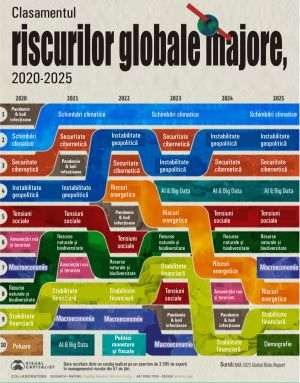The stability shown by the leu in relation to the euro starting from the second part of 2023 will very likely continue this year as well, given that the foreign exchange reserves of the National Bank of Romania (BNR) are at historical highs, we are in an election year, and the two main currencies of the world, the euro and the dollar, are also stable in relation to each other, according to the economists and analysts consulted by the BURSA newspaper.
They say that the stability of the exchange rate is beneficial for companies and individuals, who can better budget their expenses, while also being an anti-inflationary measure. On the other hand, they demand higher interest rates to finance the budget deficit, and when inflation here is higher than in the euro zone, the stability of the exchange rate equates to a strengthening of the national currency in real terms, with an impact on exports. Yesterday, the BNR quoted one euro at 4.971 lei, within the narrow range in which the national currency has fluctuated since September last year.
• Ionuţ Dumitru: "The competitiveness of exports should be ensured through other mechanisms, not through the exchange rate"
Ionuţ Dumitru, the chief economist of Raiffeisen Bank, states that the bank's forecasts indicate the maintenance of the stability of the exchange rate, with a slight depreciation somewhere around 5 lei for one euro, until the end of the year. "But such a movement of less than 1% has no significance in the financial markets", stressed Ionuţ Dumitru.
According to the economist, the main fundamental factors that will have an impact on the exchange rate are the twin deficits - the budget deficit and the current account deficit. "I would characterize the rate in our forecast as rather stable, with a very small margin of variation", Ionuţ Dumitru told us.
He emphasized that the NBR has always seen the positive sides of exchange rate stability, which are not few, but there are also certain costs that we need to be aware of. "The stability of the exchange rate when our inflation is higher than in the euro zone means, in fact, a strengthening of the national currency in real terms, which is not beneficial for the competitiveness of exports", says Ionuţ Dumitru, adding: "But the competitiveness of exports it should be secured primarily through other mechanisms. Through productivity gains, not through the exchange rate."
• Adrian Mitroi: "In my opinion, the exchange rate will rather reach the level of 4.9 lei for one euro, towards the end of autumn"
Adrian Mitroi, professor of behavioral finance and CFA analyst, draws attention to the stability of the euro/dollar currency pair which, since the beginning of last year, has been hovering around the 1.08 level (which means that one euro is equivalent to 1.08 US dollars), as well as the relationship between the leu and the two currencies.
The analyst told us: "Contrary to what it seems, the leu is a currency that appreciates "silently" (n.r. in an unobserved way), because its quotation has remained constant against the two strong currencies. Or other currencies, from the Turkish lira to the ruble, yuan or yen, all depreciated compared to the dollar or the euro. As the lion has remained constant, it means that it has appreciated".
According to the finance professor, unlike rising interest rates, which is visible, the central bank's policy of keeping the exchange rate stable against other stable currencies is a less obvious anti-inflationary measure. "It is a restrictive monetary policy, but on the "silent' side", says Adrian Mitroi.
The CFA analyst added: "This means there is purchasing power and slightly lower inflation. In practice, the financial repression on the leu, i.e. negative real interest, is not that drastic. We are in a clear process of global financial repression of which Romania cannot be a part; this is how deficits can be financed. Now the interest on the leu is probably around zero or real negative depending on the horizon considered, but it is bearable". According to the professor of behavioral finance, exchange rate stability also has a negative effect in the economy, namely high interest rates for deficit and credit financing.
• "There is an antifragile balance between the euro and the dollar, which has no reason to break," says Adrian Mitroi
The CFA analyst has a neutral outlook for the leu and believes that the national currency will rather go towards the level of 4.9 lei per euro towards the end of autumn. "I believe in the neutrality of the euro-dollar-leu. There is an anti-fragile balance (a.k.a. a system whose robustness increases following shocks, defects, etc.) between the euro and the dollar, that is, the transatlantic coordination is not only political and military, but also at the monetary level. However, this balance, the euro/dollar pair, has no reason to break, because it is well correlated politically, militarily, etc.
In our country, if we think about the reserves of the national bank and that there are elections this year, I don't think that the threshold of five lei for one euro will be reached. On the contrary, in my opinion, the course will rather reach the level of 4.9, towards the end of autumn", Adrian Mitroi told us.
From his point of view, the quotation of 5 or 5.1 lei for one euro does not regulate anything in the economy of our country. "The leu is the currency of a nation that is part of NATO and the European Union, we have solid reserves, etc", says Adrian Mitroi, adding: "There is no reason for the leu to depreciate".
• Adrian Codirlaşu: "The multi-year trend of the leu is of slight depreciation, in line with the inflation differential between Romania and the euro zone"
Adrian Codirlaşu, vice-president of CFA Romania, is of the opinion that the volatility of the leu will remain extremely low this year.
"The trend is of slight depreciation, and the participants in the last CFA Romania survey expect a level around 5 (no. lei for one euro), in the next six and twelve months. But 4.97 to 5 is very little; in other markets there are days with higher volatility", Adrian Codirlaşu told us. "The multi-year trend of the leu is of slight depreciation, somehow in line with the inflation differential between Romania and the euro zone. However, if until about two years ago the real exchange rate of the leu remained extremely stable, lately, in real terms, the leu has appreciated against the euro. This is because the exchange rate no longer depreciated in pace with the inflation differential, which practically means that the leu appreciated against the European currency".
According to the vice president of CFA Romania, the stability of the leu was also helped by the fact that our country received European funds. "We see that the BNR reserve reaches historical highs, which practically shows a euro counterpart of the leu currency issued. However, this gives great stability and very good credibility", says Adrian Codirlaşu. "In my opinion, if Romania manages to get the European funds, this appreciation in real terms of the leu can continue, even if nominally the leu depreciates".
According to the CFA analyst, the stability of the exchange rate helps companies and individuals budget their expenses better, and their savings in euros remain relatively constant. "The less good part is the high current account deficit, but a large part of it is determined by the budget deficit. Moreover, the budget deficit is the main risk for inflation, interest rates and the exchange rate", Adrian Codirlaşu told us.
According to the latest survey of the Macroeconomic Confidence Indicator carried out by CFA Romania, published yesterday, the average value of respondents' expectations for the six-month horizon is 5.0029 lei for one euro, while for the twelve-month horizon, namely February 2025, the value average of the anticipated exchange rate is 5.05 lei for one euro. According to the institution's statement, 83% of the participants anticipate a depreciation of the leu for the next twelve months.














































